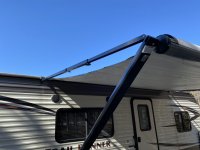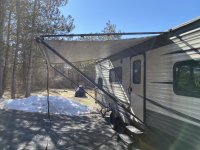You are using an out of date browser. It may not display this or other websites correctly.
You should upgrade or use an alternative browser.
You should upgrade or use an alternative browser.
New to RV’ing
- Thread starter Jobofly
- Start date
danemayer
Well-known member
Hi Jobofly,
Congratulations on the Trail Runner and welcome to the Heartland Owners Forum.
You'll probably get some feedback from Trail Runner owners shortly. In the meantime, you might want to take a look at our collection of owner-written user guides. They may answers questions you didn't know you had. Here's a link.
Congratulations on the Trail Runner and welcome to the Heartland Owners Forum.
You'll probably get some feedback from Trail Runner owners shortly. In the meantime, you might want to take a look at our collection of owner-written user guides. They may answers questions you didn't know you had. Here's a link.
Flick
Well-known member
Hey everyone, we just bought a 2018 heartland trail runner 25sle. This feels like a great family camper. Just wanted to see if anyone knew about the model, has any tips or tricks just general in about this model. Thanks in advance.
Welcome to the group. I believe you will find answers to many of your future questions right here. As with anything, get to know your camper from the hitch to the rear bumper. Know where your mechanical stuff is located and run it thru some trial runs perhaps in your driveway. Spend a night or two in it before you actually camp in it. Enjoy.
david-steph2018
Well-known member
Hey everyone, we just bought a 2018 heartland trail runner 25sle. This feels like a great family camper. Just wanted to see if anyone knew about the model, has any tips or tricks just general in about this model. Thanks in advance.
Welcome to the group from Goodyear, Arizona, for now.
danemayer
Well-known member
Locate the thermostat that operates the furnace and turn it off or adjust the setpoint temperature on the thermostat.ok first question. i hooked up power and propane and the heater started up on its own. how do i turn the heater off?
You do not want to leave your black tank valve open. And to avoid some issues use plenty of water when flushing and minimal TP.
Some people leave the grays open but you need to create a P-trap with your hose to prevent sewer gases from venting through your vent system.
In not sure if your Trail Runner has a black tank flush but if you have an extra garden hose fitting on the sidewall then maybe.
Peace
Dave
Some people leave the grays open but you need to create a P-trap with your hose to prevent sewer gases from venting through your vent system.
In not sure if your Trail Runner has a black tank flush but if you have an extra garden hose fitting on the sidewall then maybe.
Peace
Dave
Flick
Well-known member
Got it thanks. Next question, does the black tank have some kind of sprayer system to help keep it clean? Also when I’m hooked up at a full service site do I leave my black tank open or do I let it fill everyday then dump it? Same with the grey water tank?
Cookie beat me to it. But I’ll leave my comments anyhow. Lol.
I’m not sure about your particular model, but most do have a hose connection where you can add water to help clean out the black. Keep adding water if so equipped till the water runs clear. If you don’t have a clear sewer connector that attaches before the hose, you need to get one. It’ll help you see what you’re doing.
Close the valve and only dump the black tank after a few days of use. If left open, your liquid will run off and you’ll be left with a problem. After dumping, you need to add a bit of water into the tank to get you started. Just flush your toilet a few times.
We like to leave our grey tanks open although there is some concern about sewer smells backing up. Leave a sump area that creates a trap in your sewer hose to help with park sewer gases.
We close our grey tank valve the day before we’re ready to leave so we have water to help flush the hose after dumping black tank.
david-steph2018
Well-known member
Thanks for the help. New question, I have some broken running lights. Where is the best place to get new lights?
Since your rig is a 2018 you should be able to find the replacements in numerous places.
Some use E-Trailer and I go to a couple of surplus places in the Goshen area when up there for resupply.
You can try these:
Bontrager's Surplus – RV and Home Improvement Items
Rainbow Variety And RV Surplus - Goshen, IN (rainbowvarietystore.com)
For example I found the overhead LED lights at Bontragers for $5.00/each. Rainbow Variety has all the types of screws used in these things for $3.00/lb. so when I was there I ended up with some of 8 types.
Flick
Well-known member
Ok quick question. Are the outlets in the camper the same as outlets in a house? The reason I am asking is because I want to replace a few of them with outlets that have USB ports built in. Thanks
Most rv outlet plugs are designer type plugs (rectangular in shape). The covers also snap on. The wall boxes are different generally from what you’ll find in a setup other than rv’s.
However, the electrical hookups are all the same and you can use outlets with usb. Easiest would be to use a direct fit rv outlet plug with usb. You could also remove the existing plug and outlet box and go with one you can buy at Lowe’s. You can check. Lowe’s may even have one that fits an rv.
Thanks for the help. New question, I have some broken running lights. Where is the best place to get new lights?
If it is just the lens broken you can get them at any auto parts store. Probably the whole light assembly also.
david_reaves
Member
One of the things you can do for the awning is to adjust the bottom arms to put an angle on the awning, so it will drain if there is a rain shower. I like to put the side of the awning away from walking traffic a little lower than the other end. That gives a direction for any water to run off. There are lots of good YouTube videos on operating the manual awning, so I would check there if you have questions.
If there are rain showers, you can secure the ends of the awning rollers to the ground with paracord and tent stakes. That helps to keep the awning safe in moderate winds while (possibly) giving you a little dry space outside the camper. I would never keep the awning out-- even if staked down, in more than 15-20 mph winds. For mild winds, you may discover that overnight breezes make the awning noisy. With an electric awning you'd just roll it in because it is easy. Since a manual awning takes a bit more effort, many people use something called a de-flapper to secure the long, open, sides of the awning to the awning rail. I used them when I had a camper with a manual awning.
Something like this helps improve sleep on a breezy night! Depending on your awning you might choose to use two per side, but I would start with one pair and see how that works. Good luck with the new camper!
Depending on your awning you might choose to use two per side, but I would start with one pair and see how that works. Good luck with the new camper!
https://www.amazon.com/Camco-42061-RV-Awning-De-Flapper/dp/B0006IX7V0
- - - Updated - - -
- - - Updated - - -
I meant to say in my previous message that I agree that it looks okay for a standard manual awning.
If there are rain showers, you can secure the ends of the awning rollers to the ground with paracord and tent stakes. That helps to keep the awning safe in moderate winds while (possibly) giving you a little dry space outside the camper. I would never keep the awning out-- even if staked down, in more than 15-20 mph winds. For mild winds, you may discover that overnight breezes make the awning noisy. With an electric awning you'd just roll it in because it is easy. Since a manual awning takes a bit more effort, many people use something called a de-flapper to secure the long, open, sides of the awning to the awning rail. I used them when I had a camper with a manual awning.
Something like this helps improve sleep on a breezy night!
https://www.amazon.com/Camco-42061-RV-Awning-De-Flapper/dp/B0006IX7V0
- - - Updated - - -
- - - Updated - - -
Yes, manual awning. Setup looks ok to me.
I meant to say in my previous message that I agree that it looks okay for a standard manual awning.
Similar threads
- Replies
- 6
- Views
- 255
- Replies
- 1
- Views
- 434
- Replies
- 1
- Views
- 799



